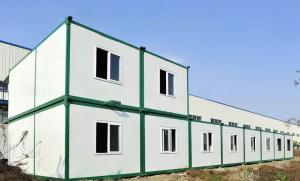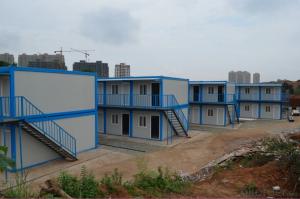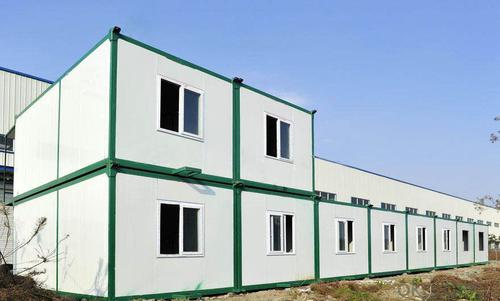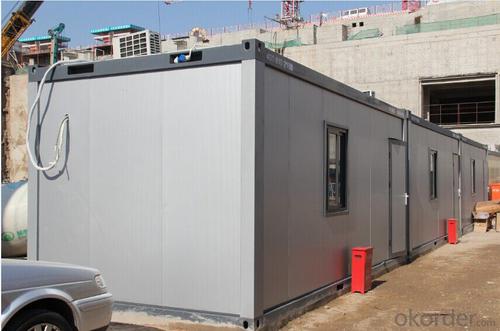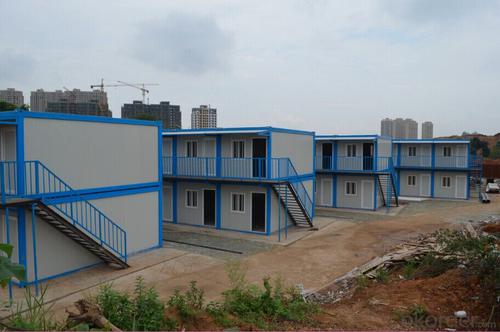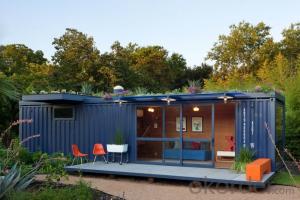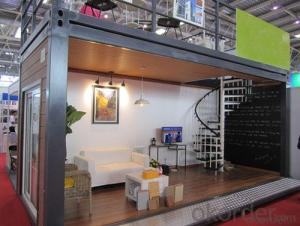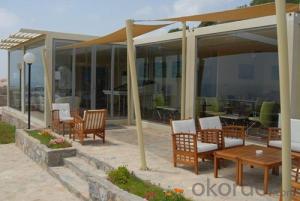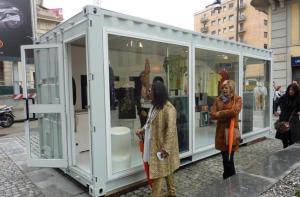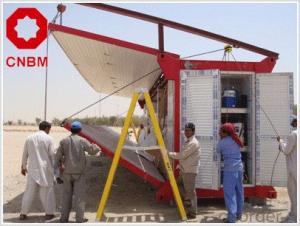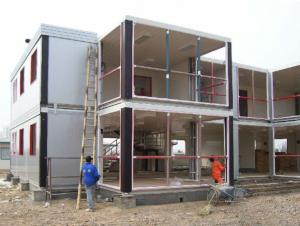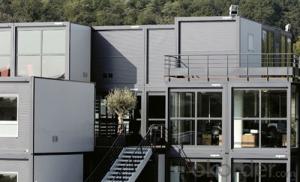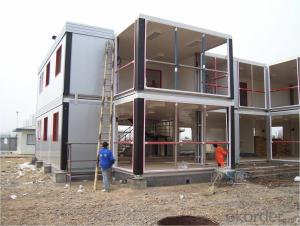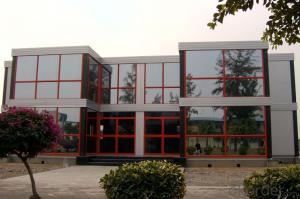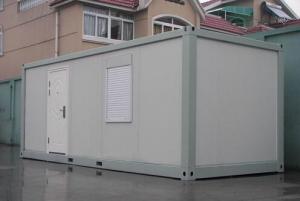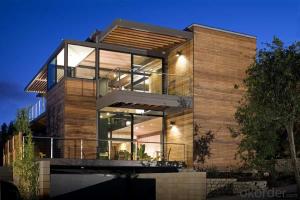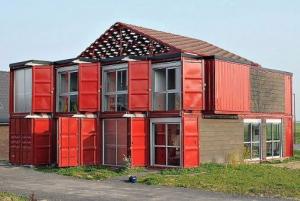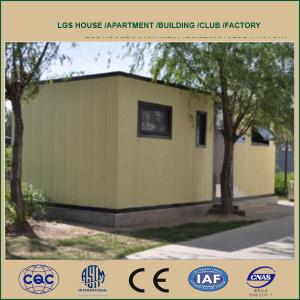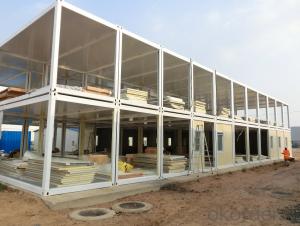Made in China Portable Container Houses
- Loading Port:
- Tianjin
- Payment Terms:
- TT OR LC
- Min Order Qty:
- 1 pc
- Supply Capability:
- 10000 pc/month
OKorder Service Pledge
OKorder Financial Service
You Might Also Like
Made in China Portable Container Houses
Product introduction
The assembled series slope roof prefabricated houses
"Constant" brand series of slope roof assembled prefabricated houses is the company launched a new concept of environmental protection building economical activities, ordinary, standard and luxury type 3 kinds.According to customer demand, in a standard module for space combination, formed the skeleton system USES light steel structure, and to sandwich panels and PU tile forming palisade and roofing system.Realize the simple and beautiful, the construction fast, use safety, the standard of general overlay idea, make the overlay houses into an industrialized production, inventory, for repeated use of stereotypes housing products.
Sex can
Reliable structure: light steel system of flexible structure, safe and reliable, satisfies the requirement of building structure design codes.
Tear open outfit is convenient: housing can be repeatedly disassembling, repeated use.The installation process need only simple tools.Average per person per day to install 20-30 square meters, 6 people a team, 2 days to complete 3 k standard prefabricated houses 1 x 10 k.
Beautiful decoration: housing overall beautiful, bright color, texture soft, board face level off, have good adornment effect.
Flexible layout: doors and Windows can be installed in any position, interior partition can be set in any horizontal axis.The stairs set outside.
The structure of the building structure waterproof, waterproof design, does not need to do any other waterproof processing.
Long service life, light steel structure anticorrosion coating processing, normal service life can reach more than 10 years.
Environmental conservation: the reasonable design, easy tear open outfit, can be used many times cycle, low attrition rate, do not produce construction waste, the average annual cost is much lower than other materials of similar houses.
Using standardized components, a variety of specifications: building length and width are to K (1 K = 1820 mm) for the module.Transverse dimensions of mk + 160, the longitudinal size of nk + 160.
With the way
Are widely used in road, railway, construction and other field operation of temporary housing construction;Urban municipal, commercial and other temporary housing, such as: temporary office, conference room, headquarters, dormitory and temporary stores, temporary schools, temporary hospitals, temporary parking area, temporary exhibition hall, temporary filling stations, etc.
Assemble series flat roof prefabricated houses
"Constant" assembled series flat roof prefabricated housing is through making full use of their own strength of sandwich wall panel and roof panel, after pulling, bolts, self-tapping screw connection and finalize the design activities of housing system.Can be industrialized production, use, interior decoration, realize the inside and outside is beautiful, fast, safe construction overlay concept, tight sealing, heat insulation, waterproof, fireproof, moistureproof.
Aesthetically pleasing: housing overall modelling beautiful, inside and outside are color decorative plates, good appearance, design and colour collocation to coordinate.
Long use period: normal service life can reach more than 10 years.Convenient transportation, dismantling recycling, environmental savings.
With the way
Are widely used in road, railway, construction and other field operation of temporary housing construction;Urban municipal, commercial and other temporary housing.Such as: temporary office, conference room, headquarters, dormitory and temporary stores, temporary schools, temporary hospitals, temporary parking area, temporary exhibition hall, temporary maintenance, temporary transformer room, temporary filling stations, etc.Other temporary housing areas, such as military logistics temporary occupancy, rescue and relief temporary occupancy, sterile laboratories, isolation rooms, communication substation room.Scenic area of temporary use leisure villa, vacation homes, etc.
Products > > activity control box, the bathroom
Box is by utilizing sandwich wall panel and roof panel connection of their own strength, by screw, bolts, self-tapping screw, wall sandwich plate and the steel structure base housing system composed of roof plate connection.Quick construction, whole movable, especially suitable for municipal facilities and field construction site of the gatehouse, service, etc.
Toilet is mainly is made of light steel structure, caigang sandwich board maintenance material, to give expulsion-typely wastewater and circulating water storage (microbes) drainage way portable toilet.Can be very convenient to install, move, move, especially suitable for streets, sports venues, the use of tourist attractions.
Fence is made of steel structure column, double color sandwich steel or single color pressed steel by bolt connection and into.All of its components are composed of standard parts, the arbitrary assembly, short installation period, the effect is good, the color can be specially made according to the requirements.Repeatable tear open outfit, use, construction waste, beautiful appearance.
- Q: Are container houses suitable for areas with limited access to transportation?
- Yes, container houses are suitable for areas with limited access to transportation. Container houses can be easily transported and assembled in remote locations, avoiding the need for extensive transportation infrastructure. Additionally, the compact and modular nature of container houses makes them adaptable to various terrains and can be easily transported by trucks, ships, or even helicopters if necessary.
- Q: Are container houses susceptible to rust or corrosion?
- Container houses, typically constructed from steel shipping containers, are designed to endure the harsh conditions of long-distance sea transportation. These containers are predominantly made from weathering steel or corten steel, renowned for their exceptional resistance to corrosion. Though container houses possess a general resistance to rust and corrosion, it is crucial to acknowledge that they are not entirely impervious to these issues. Over time, without proper maintenance or exposure to specific environmental elements, rust and corrosion may manifest. Several factors can contribute to rust and corrosion in container houses, such as exposure to moisture, salty air, and extreme weather conditions. Inadequate sealing of the containers can result in water seepage, leading to rust formation. Furthermore, damaged or worn-out paint or protective coatings on the containers may cause corrosion. To mitigate the risk of rust and corrosion in container houses, regular maintenance is imperative. This entails inspecting the containers for any signs of damage or wear, rectifying cracks or holes, and applying necessary protective coatings or paint. Proper sealing of the containers and ensuring adequate ventilation can also assist in preventing moisture buildup and minimizing the risk of rust. In conclusion, while container houses are generally resistant to rust and corrosion, they are not entirely impervious. By implementing proper maintenance and care, the likelihood of rust and corrosion can be minimized, safeguarding the longevity and durability of the container house.
- Q: What is the average lifespan of a container house?
- The average lifespan of a container house is approximately 25 to 30 years.
- Q: Are container houses suitable for remote education or homeschooling?
- Container houses can be a suitable option for remote education or homeschooling, depending on individual preferences and circumstances. These houses are typically small in size and can be customized to meet specific needs, allowing for the creation of a dedicated learning space within the home. One advantage of container houses for remote education or homeschooling is their affordability. Building a container house can be a cost-effective alternative to traditional homes, making it a feasible option for families looking to save on housing expenses and allocate more resources towards education. Additionally, container houses can be easily modified and expanded as needed, providing flexibility for growing families or changing educational requirements. Furthermore, container houses are highly portable. They can be easily transported to different locations, making it convenient for families who prefer to travel or move frequently while still maintaining a stable learning environment. This flexibility can be particularly beneficial for families engaged in remote work or those who want to expose their children to different cultures and experiences. However, it's important to consider that container houses may have limitations when it comes to space. While they can be customized to maximize the available area, it may still be challenging to accommodate multiple children or create separate study spaces within a compact structure. It's crucial to carefully plan the interior layout and consider the specific educational needs of the individuals involved. Ultimately, the suitability of container houses for remote education or homeschooling depends on individual preferences, budget, and the ability to adapt to a smaller living space. Families who prioritize affordability, portability, and creativity in designing their learning environment may find container houses to be a practical and unique option for remote education or homeschooling.
- Q: Can container houses be designed with a separate office space?
- Certainly, container houses have the potential to incorporate a distinct office space. One of the remarkable benefits of container houses lies in their adaptability and modularity, which allows for versatile designs and setups. By engaging in meticulous planning and design, it becomes feasible to integrate a separate office area within a container house. The establishment of an office space can be achieved through the division of the container into distinct sections or by utilizing multiple containers to construct separate rooms. The dimensions and arrangement of the office area can be tailored to meet individual requirements and preferences. For instance, a larger container can be exclusively designated for office purposes, or a smaller section within the container can be allocated as an office zone. To ensure practicality, it is essential to consider factors like proper insulation, ventilation, lighting, and soundproofing when designing the office space. This will contribute to the creation of a comfortable and conducive work environment within the container house. Moreover, container houses can be enhanced with additional features and amenities to elevate the office space. These additions may encompass windows to maximize natural light, integrated storage solutions, electrical outlets, internet connectivity, and ergonomic furniture. In conclusion, container houses undeniably have the potential to incorporate a separate office space. With careful planning and design, it is possible to establish a functional and comfortable office environment within a container house. This provides a flexible and cost-effective solution for individuals seeking a home-office setup.
- Q: Can container houses be built in coastal areas?
- Yes, container houses can be built in coastal areas. Container houses are made from durable materials like steel, which makes them suitable for withstanding coastal weather conditions such as high winds, saltwater exposure, and humidity. However, additional precautions may be necessary, such as proper insulation, corrosion-resistant coatings, and elevated foundations to protect against potential moisture damage and flooding.
- Q: Can container houses be insulated for energy efficiency?
- Absolutely, container houses can be insulated to improve energy efficiency. In fact, insulation plays a crucial role in transforming container houses into cozy and eco-friendly living spaces. There are various insulation choices available for container houses, such as spray foam insulation, rigid foam insulation, and insulation panels. When it comes to container houses, spray foam insulation is a highly favored option due to its exceptional insulating properties and ability to create an airtight seal, effectively preventing drafts and air leakage. It is directly applied to the container's interior walls and ceilings, forming a protective barrier that helps regulate indoor temperatures and minimize energy usage. Another alternative is using lightweight and durable rigid foam insulation boards that can be installed on either the interior or exterior of the container walls. These boards possess excellent insulation capabilities, effectively preventing heat transfer and maintaining a comfortable indoor temperature. Insulation panels made from materials like fiberglass or mineral wool can also be employed to insulate container houses. These panels are easy to install and offer solid thermal insulation, reducing the reliance on heating and cooling systems and ultimately saving energy. Furthermore, it is essential to consider insulating the roof and flooring of the container house. Insulating the roof prevents heat gain or loss through the top of the house, while insulating the flooring helps maintain a comfortable indoor temperature and minimizes heat transfer from the ground. By insulating container houses, you can significantly enhance energy efficiency, lower heating and cooling expenses, and create a pleasant living environment. It is advisable to consult professionals or experienced contractors specializing in container house construction to determine the most suitable insulation options based on your specific needs and climate conditions.
- Q: Can container houses be designed to have a minimalist interior?
- Yes, container houses can definitely be designed to have a minimalist interior. With a thoughtful and strategic approach to space utilization, clever storage solutions, and a focus on clean lines and simplicity, container houses can offer a minimalist aesthetic. The modular nature of containers also allows for customization and flexibility in designing an interior that aligns with minimalist principles.
- Q: What are the common amenities in container houses?
- Common amenities in container houses include basic utilities such as electricity, plumbing, and heating/cooling systems. They also typically have a kitchen area with appliances, a bathroom with a shower and toilet, and a living space that may include furniture and storage options. Additionally, container houses often feature insulation, windows for natural light, and security features to ensure safety and comfort for the occupants.
- Q: Can container houses be built on uneven terrain?
- Yes, container houses can be built on uneven terrain. The modular nature of container homes allows for flexibility in designing and constructing them on various types of land. With proper planning and foundation work, container houses can be adapted to uneven terrain by using leveling techniques, retaining walls, or adjusting the placement of support pillars.
Send your message to us
Made in China Portable Container Houses
- Loading Port:
- Tianjin
- Payment Terms:
- TT OR LC
- Min Order Qty:
- 1 pc
- Supply Capability:
- 10000 pc/month
OKorder Service Pledge
OKorder Financial Service
Similar products
Hot products
Hot Searches
Related keywords
